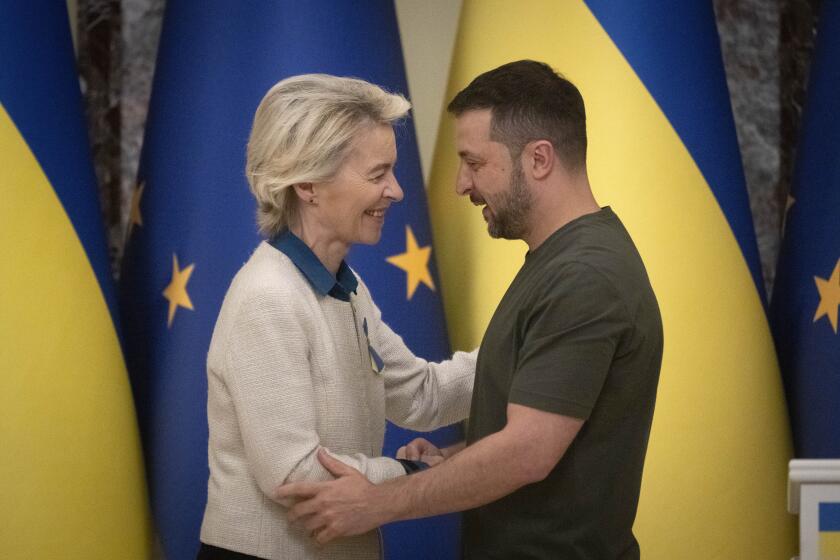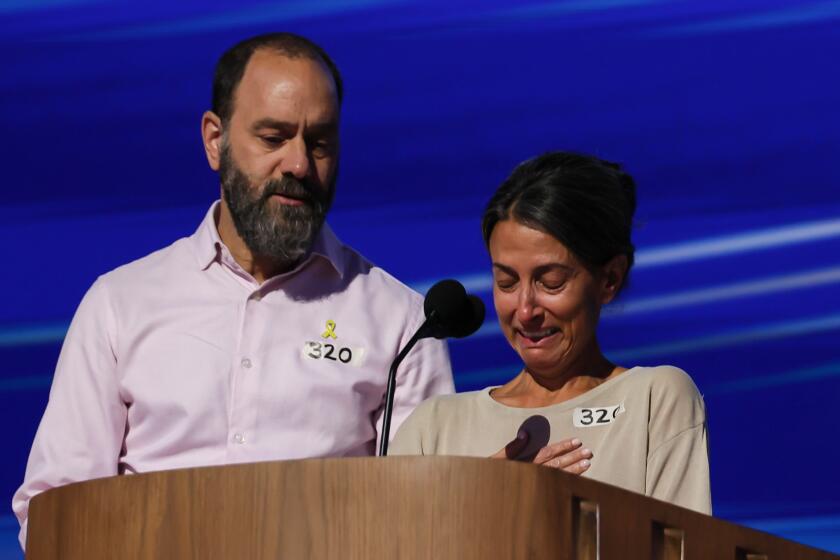SPIN CYCLE: Inside the Clinton Propaganda Machine.<i> By Howard Kurtz</i> .<i> Free Press: 326 pp., $25</i>
During his recent trip to the White House, U.N. Secretary-Gen. Kofi Annan complained that none of the reporters present was interested in any subject other than the ongoing Clinton sex scandal. “I wish you would concentrate on my issues. I don’t come every day,” Annan complained--to no avail.
Annan’s issues included the elimination of weapons of mass destruction and the avoidance of a war that likely would have left tens of thousands of innocent Iraqi dead, but the White House press corps couldn’t have cared less. It was no different than the supercilious contempt afforded other world figures who have traveled in the past months to Washington to secure the ear of our president and nation.
But it is not just international matters that are treated with this scorn of indifference. The Annan incident, which occurred after the publication of Howard Kurtz’s book “Spin Cycle,” proves to be typical of the gossipy contempt for real issues that has come to define the Washington press corps. Kurtz, media critic for the Washington Post, presents as much detail as one can stand about how the daily White House news cycle bears almost no relation to news of national and international significance. Instead, the gathering of news has been reduced to the nauseating ritual of gotcha journalism followed by presidential denial, a process that clearly explains why the public is so turned off.
They have every right to be: The Washington media elite, as portrayed here, is a collection of blathering narcissists preoccupied with the sensationalism that feeds their careers to the exclusion of anything that might interest an ordinary citizen. That is the inescapable conclusion of this valuable insider’s view of the battle between the people who cover the president and those who are paid to preserve his reputation in the face of their onslaught.
In his introduction, Kurtz warns that “Spin Cycle” is about the conflict between journalists eager to discredit and a White House equally “determined to rout the journalistic naysayers and prove that they could govern in this scandal-charged atmosphere. Neutralizing the media had become ground zero in the struggle for supremacy, and the spin would clearly be as important as the substance.”
Understand that by “substance,” Kurtz is not referring to the national debt, inflation, unemployment, the Asian economic crisis or the unfolding issues of welfare reform. Presidential spokesman Mike McCurry was prepared to answer those and other serious questions that he hoped would emerge. But no reporter ever asked. One question McCurry recently expected, Kurtz writes, was: “What was the U.S. policy on this land mines bill now before Congress?” What indeed? I would have loved to have read about how McCurry made sense of the fact that the United States is one of the few nations that has refused to sign off on the international campaign to ban land mines, whose organizers received last year’s Nobel Peace Prize. But, again, no reporter ever asked.
It is a testament to the superficiality of the White House press corps and the influential editors, anchor stars and columnists who buttress them that issues ofpublic policy are rarely raised in this 326-page book. There are 18 references to Paula Jones in the index but none to welfare. Fund-raiser John Huang rates 16 references, but Saddam Hussein, with whom we almost went to war, does not appear. Even Kurtz, like a sportswriter covering golf, is invested in the game being covered though he acknowledges, in various asides, that it is hugely boring.
No one can doubt the expertise that Kurtz brings to the game of political spin. He knows all of the players, and many have obviously confided in him, expecting these favors to advance their careers. That is a given, because one thing the book does establish is that career advancement is all that really matters: “For all the animosity, the White House spinners and their cynical chroniclers were ultimately joined at the hip in a strangely symbiotic relationship. . . . McCurry and company needed the press to peddle their message to the public, and the journalists needed an action-packed presidency on which to build their reputations and name recognition.”
Nor will McCurry, “smart as hell and extraordinarily helpful,” and the others on both the White House and visiting media teams, who entrusted Kurtz with their confidences, be disappointed. He pays them the compliment of taking their petty bickering and incessant whining seriously. But to anyone not initiated into the sacred rituals of the game, the participants seem like any other group of self-absorbed, overpaid athletes submerged in their sporting careers and devoid of ideas or concerns regarding life outside the stadium. They speak comfortably in the self-inflated but vacuous idiom of a wide receiver turned television announcer.
Clearly the ambition of this generation of journalists is to exceed the high-scoring days of Watergate. They are paced by the still-performing veteran Bob Woodward, mentioned frequently here, but most often the yardage is chalked up by those for whom Nixon and his crimes are only a movie memory.
Kurtz himself falls into the trap of believing that presidential history begins with Watergate: “As the campaign financing scandal exploded, McCurry found himself facing the question that had dogged every presidential press secretary since the Nixon administration: whether it is possible to tell the truth, or something approximating the truth, in a highly polarized and constantly shifting political atmosphere.” Was this not a problem for pre-Nixon presidents, say Lyndon Johnson, when he made lying about Vietnam the essence of his governance?
There is a generational parochialism at work here in the underlying assumption that the spin of the Clinton White House is somehow uniquely skillful. Yet nothing the Clintonites have accomplished in the way of media manipulation matches the flawless performance of spokesman Mike Deaver during the Reagan years, particularly when he had to explain those long stretches when the president was off dozing in another world. Kurtz acknowledges that Deaver, “who had choreographed much of Ronald Reagan’s presidency, was legendary for his steadfast belief that television pictures mattered far more than what the correspondents said. The entire Reagan administration was a made-for-TV enterprise, a daily staging of visuals for the networks.” What he seems to miss is that it was a far more effective exercise in media manipulation than anything that the Clintonites have pulled off. Just consider Reagan’s effective stonewalling to the end on Iran-Contra, compared with this White House’s fumbling on Whitewater and Lewinsky.
But who cares how well they manipulate? The basic error in this book is to judge the spinners by their own amoral standards. Dick Morris is derided here not as the cynic who helped the conservatives capture Congress and then brokered Clinton’s approval of their welfare reform program but as a brilliant operator who overreached. The press is chided by Kurtz for having missed the story that “the president had knowingly employed a political strategist who had fathered an illegitimate child.” But then again, a writer who doesn’t know that branding a child as “illegitimate” is inherently pejorative toward the child probably is not tuned in to the welfare debate.
The big question, barely raised and never answered by Kurtz, is why the public remains so impervious to the antics described in this book. The answer preferred by the media folk, who earn a good living off this endless play-by-play, is that the Clintonites are so effective at manipulation that the public never catches on.
This leaves the elite media sounding like sore losers in a game they should have easily won. Indeed, in Kurtz’s telling, the White House is inept more often than not and in an almost permanent state of estrangement from the media folks they are supposed to be cajoling. Both Hillary and Bill Clinton seem to have developed a transparent contempt for the shallowness of the press corps; matters of war and peace, the economic well-being of the populace and the sustenance of its health and education are interpreted by the media as politically motivated gimmicks. It is no small achievement that the president manages to govern despite the media’s persistence in making matters of sleaze and scandal the national political agenda.
Just why the media are so indifferent to truly important news is an important question that unfortunately will have to be more fully explored in some other book. Kurtz alludes to the high income level of top Washington journalists but only hints at the possibility that the perks of their profession distance them from ordinary human concerns like joblessness and inflation. The corruption of the Fourth Estate is clearly a major story that needs to be told, but Kurtz only teases the subject with paragraphs that all too briefly consider the class bias of elite journalists: “[I]t was this same self-absorption that caused many reporters to dismiss much of Clinton’s agenda as small-bore. Take the Family and Medical Leave Act. It wasn’t a big deal for a hotshot journalist to take time off from work if his or her kid was sick, but for a factory worker in Illinois, the new law was a godsend.”
The career needs and class ambitions of elite journalists, including the prosecutorial fraternity of investigative journalists who Kurtz indicates are, not surprisingly, enamored of special prosecutors, also coincide with the monied interests of the conglomerates and privileged families who pay their salaries. The old division between the ink-stained wretches and the arrogant corporate suits struggling over the integrity of journalistic art is long gone. Also gone is the assurance that some patrons are far better than others. The quest for sales and ratings on the part of owners and top managers has reduced once distinguished news organizations to the level of Rupert Murdoch’s New York Post. That there is no apparent difference in the behavior of the White House reporters for the New York Post and the New York Times is one of the valuable, if under-explored, contributions of this book.
I don’t know if this was Kurtz’s intention, but no tabloid journalist comes across as more reckless and supercilious than New York Times columnist Maureen Dowd, emulated by other print reporters for her “nasty, snarky, but invariably funny column.” Kurtz is evidently easily amused by Dowd, but what comes through is Dowd’s conviction that nothing the president ever does can be judged worthwhile. Clinton’s second term, in which the budget was balanced, real wages rose and inflation and unemployment are at a 25-year low, has been dismissed by her as “shrunken,” “defeated” and “aimless.” Dowd seems incapable of treating a single aspect of public policy as important. In her appearances in “Spin Cycle,” politics is style, rendering the New York Times’ treatment of presidential politics on its op-ed page no different than its coverage of fashion--even kinky fashion, as in Dowd’s reference to “those rumors about that bald eagle tattoo” on the president’s penis.
By comparison, the Clintonites seem serious in their attempts to take care of what they call “the nation’s business” despite the journalists. By the end of what was intended as the book’s final chapter--the publisher pulled the galleys after Monica Lewinsky hit big and Kurtz penned a new conclusion--the media seem really beside the point and the public sensible in focusing on matters other than scandal. After all, as he admits almost ruefully, the public is enormously approving of the way Clinton governs.
Oddly, what emerges is a portrait of Clinton, drawn virtually in absentia, that is quite flattering. While the press corps and its handlers squabble in the sandbox of their minds, Clinton is shown dealing with what the rest of us do care about, as boring as Maureen Dowd may find it. By contrast, the journalists seem petty beyond belief. Michael Frisby of the Wall Street Journal stands out as particularly vengeful when his ambitions are bypassed; “I’m going to f--- you,” he screams at White House aide Rahm Emanuel after being passed over on the leak of some story. “Emanuel knew exactly what Frisby meant,” Kurtz writes. “Frisby was renowned inside the White House for tossing poison darts at uncooperative aides in the Journal’s gossipy, anonymously sourced ‘Washington Wire’ column, which ran on the front page every Friday. No one wanted to be the next target.” True to form, Frisby seems to love playing the schoolyard bully, threatening to expose one Clinton aide for chatting with ABC executives in the hallway with the charge that he was soliciting a job with the network. “We’re desperate for ‘Washington Wire’ items,” he said. “Give me something else or I’m going to have to use this about you.”
If “Spin Cycle” had ended as Kurtz first intended, Clinton would have emerged the obvious winner. But the epilogue is curious, for Kurtz reverses himself and jumps to the conclusion that Clinton is just about finished. “The damage to his presidency would never be repaired. . . . [T]he spin-meisters could no longer save him from himself. The president would have his place in history, but it is not the one he had imagined.”
Perhaps, but is that fair? By the standard of the media scandal mongers, many of our great presidents would have been judged even more stunning failures than Clinton. Personally, I think Clinton will be judged harshly if his very risky welfare reform proves a failure during the inevitable downward swing of the business cycle. But doesn’t he also deserve considerable credit for the controversial economic initiatives of 1993, which cost his party control of the House but contributed to a booming economy? Will he not be remembered for balancing the budget, for keeping us out of war and for low unemployment and inflation? Or do reporters, Kurtz included, just not care?
More to Read
Sign up for Essential California
The most important California stories and recommendations in your inbox every morning.
You may occasionally receive promotional content from the Los Angeles Times.










